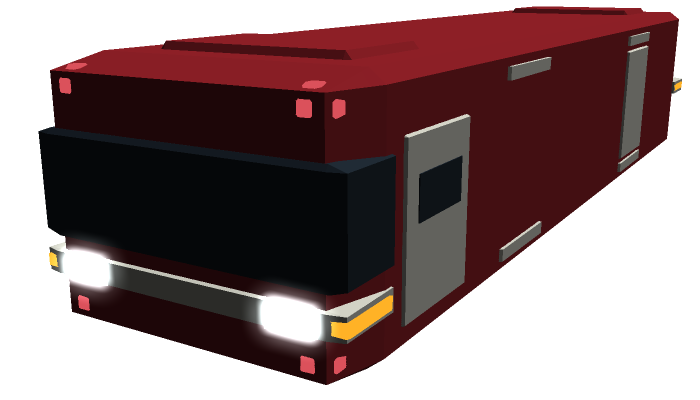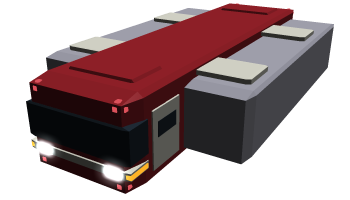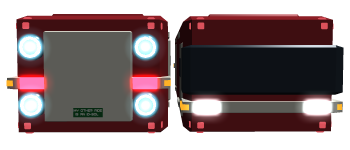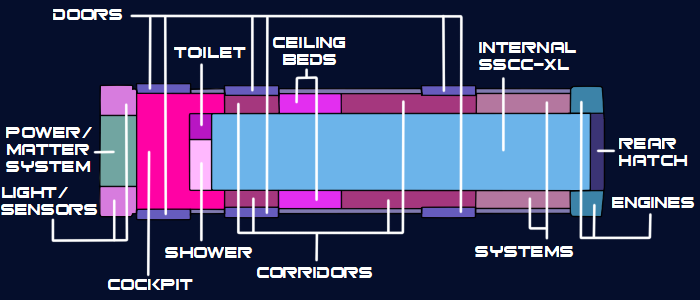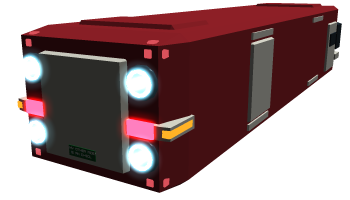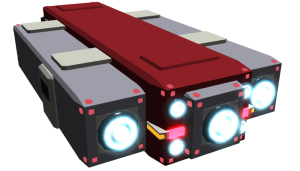Table of Contents
Hauler-class Logistics Ship
The Hauler is a low-cost civilian cargo and transport vessel built out of an SSCC Huge and is designed to be easily built, piloted, and customized. Its intent is to cultivate small business infrastructure and make interstellar travel easily accessible on a budget. The Hauler was initially developed by Kage Yaichiro in YE 40 for sale by the Sunflower Corporation. It costs 9000 KS (18000 DA) with a 12% discount to various entities and 20% off if two SSCC-Huge Cargo Containers are provided. Payment plans and options exist which allow many people, including any member of the Star Army of Yamatai, to theoretically afford one.
About the Hauler
The purpose of the ship was centered around economic re-development and lowering the barrier of entry to interstellar space travel for the populace. The Hauler is intended to be a long-lived workhorse that can be produced and repaired profoundly cheaply by using existing systems for its hull and components. It was also important to make something that did not require shipyards to produce, due to the need to allocate those to military purposes. Its ability to carry SSCC-XL or smaller allow it to function much like a “space truck”, though these SSCCs can be purchased or modified to carry personnel easily and tie into the vessel's life support to make them into “space buses”, or even “space campers”. Custom modules can also be employed and attached as SSCC-XL. As such, the craft is of a type that can be readily customized for many purposes. It is not uncommon to see ones customized with added weapons and larger supplemental engines.
Key Features
The Hauler can carry a single SSCC-XL internally, be it completely enclosed by the ship or with the rear extending outward for a drop-in engine upgrade, and up to two more SSCC-XL when employing its external mounting points. These SSCC-XL can be the purpose-built SSCC-XL Prefab Modules, the typical cargo containers, or can be altered into various forms as needed by the end user.
It should be noted that the vehicle can fly in the atmosphere and hover above a roadway, but it requires at least two lanes of traffic to do so and this is without carrying additional containers on its sides. Local laws must be checked to verify roadway legality and any required licensing.
Mission Specialization
Though able to carry cargo in its basic form, the vessel is designed for the use and transport of SSCC-XL Prefab Modules or SSCC-XL. With this capability, it is possible for the Hauler to serve a myriad of roles depending on what is attached and how it is employed. It is also common for the Hauler to be attached to SSCC-XL with custom modifications such as larger engines or other upgraded systems. It is intended for, but not limited to, the following roles and module types:
- Cargo (SSCC-XL, SSCC-XL Endcap Module)
- Transport (SSCC-XL Passenger Module)
- Residential (SSCC-XL Living Module)
- Customization (SSCC-XL Engine Module)
Appearance
Being built from two SSCC-Huge Cargo Containers, one solid external one and another cut up for internal bulkheads, the Hauler maintains the base rectangular shape of the SSCC-Huge in which it is built. All components are added to this frame. The dark components that appear to be windows are actually armored sensor panels with hull under them. The Hauler has headlights, turn signals, and taillights which also double as sensors. Each corner of the vehicle has three red plasma emitters, which are used for directional control and orientation as well as weapons. The rear has a large loading door as well as four large plasma engines with a white-blue exhaust. Plates along the top and bottom of the craft conceal graviton beam projectors for towing, road use, and affixing to the hulls of larger craft.
History and Background
When Kage Yaichiro started working to rebuild Tokyo in YE 39, he knew restoring the city alone wouldn't be enough. He needed to make infrastructure for the people there and give them means to sustain themselves. One of the means by which to do this was to find ways to provide low-cost equipment which could be used by people to make a living. For this as well as the repair of the city itself, he founded the Sunflower Corporation.
In YE 40, Yaichiro chose to produce a cost-effective spaceship which was not the fastest nor the most powerful, but rather cost-effective and serviceable. It would also be possible to produce the vessel while volunteering the company's shipyards for military use. That would be the Hauler-class Logistics Ship. It would be able to carry up to three SSCC-XL which could be standard cargo containers or modified ones for various purposes like transport, living, or even plug-in customizations. Pre-made modules of this type are sold as SSCC-XL Prefab Modules.
Price and Payment Plans
The Hauler costs 9000 KS or 18000 DA). While already considered cheap for a ship, the fact that this is a large cash outlay is understood and interest-free payment plans exist. There is a 12% discount to soldiers and veterans of the Star Army of Yamatai, the Scientific Studies Service (SSS), and the Star Military of the Democratic Imperium of Nepleslia. It is also possible to drop the cost by another 20% if one supplies two SSCC-Huge for the construction process (which combined must result in a structurally sound SSCC-Huge and another with up to 10% damage). This encourages the reuse of SSCC-Huge Containers, even ones with minor damage that can be cut up for internal bulkheads.
This plan was built around Star Army of Yamatai personnel. Even the lowest ranked soldier can afford this payment and buy the ship in a year's time. It is also a low enough cost to where those on the Yamatai Prestige System instead of pay may have a chance of receiving the vessel if they have served for long enough. It is possible to arrange a longer pay period in exchange for shorter payments, though this may involve interest.
| Plan Type | Amount | Payments per Year | End Total |
|---|---|---|---|
| Yamatai Star Empire (or other KS users) | 1000 KS | 9 | 9000 KS |
| Yamatai Star Empire (or other KS users) + 2 SSCC-Huge | 800 KS | 9 | 7200 KS |
| SAoY/SSS (Veteran or Active) | 880 KS | 9 | 7920 KS |
| SAoY/SSS (Veteran or Active) + 2 SSCC-Huge | 680 KS | 9 | 6120 KS |
| Democratic Imperium of Nepleslia (or other DA users) | 1500 DA | 12 | 18000 DA |
| Democratic Imperium of Nepleslia (or other DA users) + 2 SSCC-Huge | 1200 DA | 12 | 14400 DA |
| SMDIoN (Veteran or Active) | 1320 DA | 12 | 15840 DA |
| SMDIoN (Veteran or Active) + 2 SSCC-Huge | 1020 DA | 12 | 12240 DA |
Statistics and Performance
The Hauler is a simple ship which functions similar to a large shuttle with logistics capacity and is designed for a minuscule crew of one or two to operate. It has moderate STL engine speed for its type and a large array of 24 verniers in hopes of fleeing threats. While its FTL speeds aren't impressive, they are serviceable and include hyperspace capability. Every measure of these aspects can be improved by adding SSCC-XL Engine Modules to make the ship faster and more maneuverable.
General
The Hauler was made by Sunflower Corporation (SC), and is from the first line of civilian vessel (Y1), first class (1), first revision (A).
- Class: SC-Y1-1A
- Type: Civilian Logistics Vessel
- Designers: Kage Yaichiro
- Manufacturer: Sunflower Corporation
- Fielded by: Civilians and assorted factions
Passengers
There are accommodations for 2 people unless SSCC-XL Prefab Modules or other specialized SSCC-XL variants are employed. Each SSCC-XL Passenger Module can carry 30 people (10 rows of 3 people) and each SSCC-XL Living Module can comfortably sleep 4 people. These custom types can also be detached as escape pods.
- Crew: 2 operators are recommended, 1 is required.
- Maximum Capacity: 4 people unless modules are attached. It would be rather cramped, however.
Dimensions
This module has the exact same dimensions as an SSCC-Huge and can be stored in all the same places and methods for shipping purposes.
Propulsion and Range
The Hauler is designed for durability and ease of repair, and as such has lower base speeds. It can, however, have these capabilities enhanced by adding up to three Engine Modules.
- Continuum Distortion Drive: 7,500c + 1,000c for each SSCC-XL Engine Module6)
- Hyperspace Fold Drive: 0.30 ly/m + 0.05 ly/m for each SSCC-XL Engine Module7)
- Sublight Engines: 0.275c (82,443 km/s) + 0.05c for each SSCC-XL Engine Module8)
- Range: Theoretically indefinite
- Lifespan: 30 years, extendable by hull or system replacements
- Refit Cycle: 10 years in cases of heavy use
| Propulsion Type | Base | 1 Engine Module | 2 Engine Modules | 3 Engine Modules |
|---|---|---|---|---|
| Continuum Distortion Drive: | 7,500c | 8,500c | 9,500c | 10,500c |
| Hyperspace Fold Drive: | 0.30 ly/m | 0.35 ly/m | 0.40 ly/m | 0.45 ly/m |
| Sublight Engines: | 0.275c | 0.325c | 0.375c | 0.425c |
Damage Capacity
See Damage Rating (Version 3) for an explanation of the damage system.
- DRv3 Tier: Tier 8, Medium Mecha
Inside the Ship
The interior of the vessel is profoundly simplistic and spartan, as one might expect from the prospect of a cargo container turned into a ship. Despite this, however, there are facilities for living through multi-day operations which meet the needs of a small crew.
Deck Layout
Compartment Layouts
All hull sections and bulkheads between areas are made of 20cm thick walls of Durandium Alloy. All rooms, if necessary, can seal to protect against decompression.
Cargo Container Area
The cargo container area is, at its simplest description, a vacant 15m x 2.5m x 3m cavity that has connections at the top and bottom for power and data. It is meant to hold an SSCC-XL inside the vessel, though it can be converted for other purposes. Conversion is not common, however, as it is possible to use SSCC-XL which have been converted for various purposes and make any such changes non-permanent to the ship.
Ceiling Beds
The ceiling beds are simply stowable beds (each measuring 2.5 meters by 0.8 meters) which are stored in and descend from the ceiling above a walkway. The floors have storage for clothing and other personal items as well. There are two in the ship, providing a place to sleep during travel. The beds can be anchored along the passageway and can even have restraints to protect against turbulence if needed.
Cockpit
The cockpit is a two-seat area which is the most spacious on the ship aside from the cargo container area. It doubles as the main living space within the vessel when not equipped with supplemental sections via SSCC-XL containers. The two consoles used to control the ship are the civilian Zero-Gravity Kiosk Console, Type 39 with touchpad input. In a case where the main computer is damaged, these consoles each hold an emergency computer from which either one can take over. The cockpit is also lined with Volumetric Windows which can serve as general displays while also serving as virtual windows outside the vessel.
Corridors
The corridors are quite simply corridors which run along the port and starboard of the craft, though they have access to ship systems as well as floor and ceiling access to food and supplies for the crew.
Shower
The shower is a simple walk-in offering that also has a cabinet inside along the back wall for clothing and bathing essentials. It is separate from the toilet in case of 'gaseous emergencies', though users should attempt to avoid leaving the ship completely unmanned if someone is already occupied in the toilet or shower. A door connects the toilet and shower mainly because this shower is used as a panic room if the vessel is attacked or if the cockpit is decompressed and toilet access is essential. A waterproof touchscreen on the wall allows rough control of the vessel if needed from this room.
Toilet
The toilet is a very simple affair with a toilet, a washbasin, a mirror, and a small cabinet on the wall. There is a door on either side, one to the cockpit and the other to the shower. The latter door is rarely used, however, unless the shower is being used as a panic room with the toilet needing to remain accessible.
Ship Systems
The systems in the Hauler are not the most advanced, but they are rather cost-effective and functional. All are designed to function for a long time between servicing cycles and are meant to be easy to repair and swap out.
Armored Hull and Hull Integrated Systems
Constructed out of SSCC-Huge made out of 20cm thick Durandium Alloy, specifically one intact for the outer hull and 90% of another one disassembled and rearranged for internal bulkheads, the vessel inherits the durability of the container. Components are attached in a way so as not to compromise this structural durability and windows are simply screens reading sensors positioned on the other side of the craft's hull. Each bulkhead and the interior of the hull itself is lined with a foam which has both shrapnel capturing attributes and expands when exposed to vacuum. These aspects give a measure of protection against penetration and decompression.
Doors
The craft has four doors, two of them per side. The front two doors lead to the cockpit, while the rear two doors are meant to provide access between the corridors and the exterior of the vessel, or even to a pair of connected SSCC-XL Prefab Modules. As such, they can function as an airlock junction in these cases.
External Mounting Points
These connections allow two SSCC-XL or SSCC-XL Prefab Modules to be mounted to the vessel, one per side. They have gravimetric, grasping, locking, and molecure systems to ensure a strong and redundant connection without requiring it to be permanent.
Rear Hatch
To the rear, a large hatch exists that allows for the insertion or removal of an SSCC-XL or smaller cargo. When an SSCC-XL is not present, it can instead act as an airlock. Sometimes, the rear of an SSCC-XL Engine Module or other similar engine upgrade extends past this rear hatch and is anchored into position to provide more thrust.
Combined Field System
The Combined Field System is a staple of shielding technology as well as propulsion. While nowhere near the capacity of military offerings, it is still capable of protecting the craft from some civilian threats as well as debris. The Combined Field System can function in a bubble form or a hull-conforming form, the latter made even more efficient due to the simple geometry of the craft with or without side containers.
Computers and Electronics
The integrated computer and communications system is a basic one which ships with the RICE OS unless a different operating system is desired. Assorted sensors are also located across and within the vessel to provide internal and external data, with supplemental sensors doubling as lighting and windows. Civilian Zero-Gravity Kiosk Console, Type 39 with touchpad input are present as both a control interface and as a backup to the main computer. In a case where the main computer is damaged, these consoles each hold an emergency computer and independent communications system and either one can take over. A touchpad input on the wall of the shower room can also be used to control the ship if the cockpit is inaccessible.
Emergency Systems
Though too small to have its own escape pods, the vessel is capable of ejecting its SSCC-XLs, be they external or internal, and have them activate any escape pod functionality they may possess. It is also possible to use the shower and toilet areas as a combined panic room complete with independent atmospheric control.
Graviton Beam Projectors
Graviton Beam Projectors are located in the cargo container area as well as on the exterior of the vessel in matched pairs underneath armor plate. They function by creating and manipulating gravitational pulses to manipulate objects around and even within the ship. There are four matched pairs - two pairs each atop and below the vessel. These are used to manipulate, load, and unload cargo as well as other functions related to the vessel itself. The craft can cling to other larger vessels for faster transport in emergencies and is also able to use these projectors to propel itself under gravity. In this way, it can be used planet-side.
Life Support Systems
The life support systems involve the standard air and water processing and recycling systems as well as artificial gravity, but it tends to be supported by the Power/Matter System.
Propulsion
The vessel has assorted kinds of propulsion available, especially for its size. It is geared toward reasonably swift slower-than-light propulsion and adequate faster-than-light propulsion. Note that these attributes can be expanded through SSCC-XL Prefab Modules or other customized SSCC-XL on the sides and/or interior of the craft.
Plasma Projection System
Four plasma engines are used for the ship's primary slower-than-light propulsion, and taps from the same system are used to feed twenty-four verniers, three per corner of the vessel. Combined, these are known as the Plasma Projection System. These components are usually fusion-powered, but it is possible to filter plasma from an after-market Aether Generator to power them if needed. Though low-tech, this allows the craft to reach a relatively solid speed of 0.275c while having a good turning capability. It should be noted that the plasma engines and verniers are also configured to act as the ship's sole weapon system and were integrated to save cost and optimize coverage. This top speed can be expanded to up to 0.425c through the addition of 3 SSCC-XL Engine Modules in increments of 0.05c per module.
Graviton Beam Projectors
While not the first choice for use as a form of propulsion in space, the Graviton Beam Projectors can assist in turning and moving the vessel by creating and manipulating gravitational force. Graviton Beam Projectors are used as the main form of propulsion and steering when on the ground.
Combined Field
The Combined Field System, which includes the Continuum Distortion Drive, is the mid-tier of FTL transportion for the ship. It is capable of a typical top speed of 7,500c and this top speed can be expanded to up to 10,500c through the addition of 3 SSCC-XL Engine Modules in increments of 1,000c per module.
Hyperspace Fold
Hyperspace Travel is used for long-distance interstellar travel. The speed of this system is 0.30 ly/m, or eighteen light years for every hour of travel from a realspace perspective. This takes five minutes to charge and the top speed can be expanded to up to 0.45 ly/m through the addition of 3 SSCC-XL Engine Modules in increments of 0.05 ly/m per module.
Power/Matter System
This system allows for the re-sequencing of matter into power or vice-versa, via the civilian version of the Fabrication Chamber. While it is possible to use a small after-market Aether Generator in a different part of the vessel as an alternate source of matter, a key source of materials is an intake at the front of the ship which collects hydrogen from space or water vapors from within an atmosphere for fusion fuel. The materials created by this system are limited to civilian offerings and it is more often used to re-sequence waste, trash, and carbon dioxide into something of use to extend the vessel's life with fewer supplies.
Weapons Systems
The ship has only one weapon system array in which its point defense and main armaments are integrated, though its point defense has 360-degree coverage with significant overlap. A downside is that the point defense is weak enough to where it does little actual damage to anything larger than a mecha or starfighter. Another downside is that the more powerful weapons are rear-facing only. Still, the craft should be running away from whatever is attempting to attack it anyway.
Finally, it should be noted that no matter how many Plasma Guns are available with docked modules, only 40 can be fired at any given time due to technical limitations. Which 40, however, can be adjusted as needed.
This weapon is tiers compliant.
Base Weapons (no SSCC-XL Prefab Modules)
Maximum Weapons (three SSCC-XL Engine Modules)
- 3 Tier 8 (Medium Anti-Mecha) Plasma Projection System Plasma Cannons (3 OTWs)
OOC Notes
Toshiro created this article on 2018/05/18 00:42; approved it (using the checklist) on 2018/11/18 18:24.
| Products & Items Database | |
|---|---|
| Product Categories | starships |
| Product Name | Hauler-Class Logistics Ship |
| Nomenclature | SC-Y1-1A |
| Manufacturer | Yugumo Corporation, Sunflower Corporation |
| Year Released | YE 40 |
| Price (KS) | 9 ,000.00 KS |
